Last Updated on January 6, 2024 by Kittredge Cherry
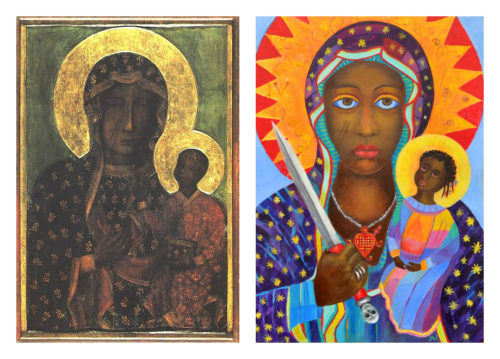
The Black Madonna of Czestochowa, one of the most famous Catholic icons, is the model for a Haitian Vodou goddess who protects lesbians.
Traditional images of Erzulie Dantor, the Vodou defender of lesbians, are based on the Black Madonna of Czestochowa, whose feast day is Aug. 26. They even share the same two scars on the dark skin of the right cheek.
Aug. 26 also happens to be Women’s Equality Day — the date when women got the right to vote in the United States in 1920.
Every year more than 4 million people view the original Black Madonna of Czestochowa icon at Jasna Góra Monastery in Poland, one of the most popular Catholic shrines on the planet. John Paul II, the Polish pope, was devoted to her. Few suspect that the revered icon of the Blessed Virgin Mary has a lesbian connection.
Our Lady of Czestochowa is among dozens of Black Madonna icons remaining from medieval Europe. The reason for their dark skin is unknown, but people speculate that the images may have been created black to match the color of indigenous people or they turned black due to smoke and aging. Some see her dark skin as a metaphor for the earth or a reference to the lover in Song of Songs who declared, “I am black but beautiful.”
Black Madonnas are said to embody the shadow side of the Divine Feminine, the unconscious and unpredictable aspects that are usually buried or kept in darkness. Erzulie Dantor reveals Mary’s hidden bonds with lesbians.
Legend says that the Czestochowa portrait of Mary was painted by Saint Luke the Evangelist while she told him the stories about Jesus that he later wrote in his gospel. The icon traveled from Jerusalem through Turkey and Ukraine, ending up in Poland in 1382. The painting is considered so important that it even has its own feast day: Aug. 26, the date that it was installed at its current home. In the 15th century looters pried two jewels off her cheek, leaving a characteristic pair of marks.
Black Madonna of Czestochowa traveled to Haiti
Events in Haiti soon took Our Lady of Czestochowa in a new direction. In the 18th century hundreds of thousands of enslaved people were brought from Africa to Haiti, where they were forced to do heavy labor and convert to Christianity. Through the process of syncretism, they developed a hybrid form of Christianity mixed with Vodou, an ancestral folk religion from West Africa.
Copies of the Black Madonna of Czestochowa were brought to Haiti by about 5,000 Polish soldiers who fought on both sides of the Haitian Revolution starting in 1802. She was transformed into Erzulie Dantor when Haitians merged her with Vodou.
Erzulie Dantor is a loa or lwa (Vodou spirit) who is recognized as a patron of lesbians. Her name has many alternate spellings such as Ezili Danto. She fiercely loves and defends women and children, especially lesbians, independent businesswomen, unwed mothers, and those who experience domestic violence. She has a reputation for taking revenge on abusive husbands and unfaithful lovers. Scar-faced warrior Erzulie Dantor liberated slaves by helping to start and win the Haitian Revolution. She is fond of knives, rum and unfiltered cigarettes.
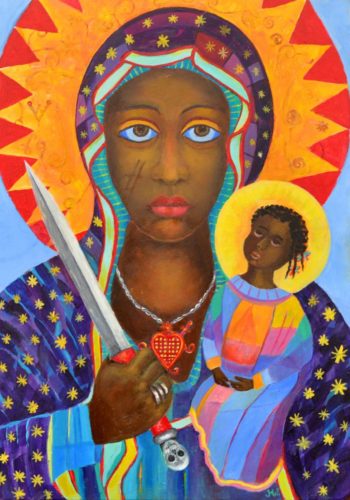
Erzulie Dantor from the Tanabe Studio Etsy shop
Like Our Lady of Czestochowa, she holds a child with a book. But instead of the infant Jesus with the gospels, the baby on her lap is her daughter Anais. The Catholic Church in Haiti identifies these images as neither Erzulie Dantor nor Mary, but “Saint Barbara Africana.” Erzulie Dantor is a single mother who has given birth, but some believe she is bisexual or lesbian herself. he shining hem of her cape becomes a dagger.
The two scars on her cheek are explained either as tribal scarification or wounds from a fight with Erzulie Freda, her light-skinned and coquettishly feminine sister. Erzulie Freda, the goddess of love and sexuality, is the patron of gay men, especially drag queens and those who are effeminate. She is associated with images of the grieving Mary as Our Lady of Sorrows.
10,000 rainbow Marys rise in Polish protest
A huge, influential international controversy erupted in Poland in 2019 over an icon that adds a rainbow halo to the Black Madonna of Czestochowa. Elżbieta Podleśna, Anna Prus and Joanna Gzyra-Iskandar were arrested in 2019 for “offending religious sentiments” on charges that they put up posters of this rainbow Mary as a protest against anti-LGBTQ church policies.
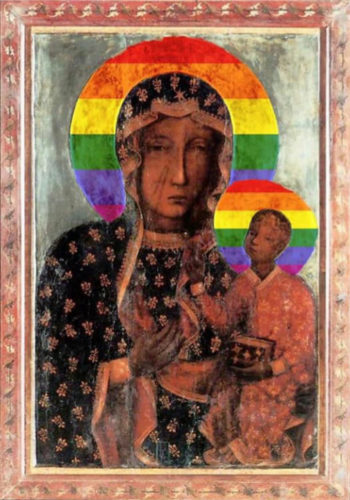
This Rainbow Madonna of Częstochowa image sparked international controversy
The arrest got major international news coverage and support from Amnesty International. Hundreds of people carried the icon in protest marches called the “10,000 Rainbow Marys” in Warsaw. They could have gone to jail for two years, but after a long legal battle, they were acquitted.
Prosecutors appealed the decision, and the three women activists were acquitted again in January 2022 when the court dismissed the appeal. As of September 2022, opponents were appealing to the Supreme Court so the case was still not finished.
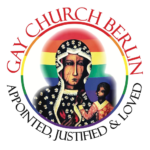 Attacks on the Polish rainbow Mary did not end there however. More than 30 Member of the European Parliament from Hungary, Poland, Italy, Greece, Spain, Croatia, Lithuania, and Germany wrote an open letter to the director of the House of European History (HEH) in June 2022 demanding that the image be removed the House of European History museum in Brussels.
Attacks on the Polish rainbow Mary did not end there however. More than 30 Member of the European Parliament from Hungary, Poland, Italy, Greece, Spain, Croatia, Lithuania, and Germany wrote an open letter to the director of the House of European History (HEH) in June 2022 demanding that the image be removed the House of European History museum in Brussels.
The continuing impact of the rainbow Madonna protest reaches far beyond Poland. GayChurch Berlin in Germany uses rainbow Madonna of Czestochowa in its logo.
A church in Oklahoma got permission from Podleśna to use her rainbow Mary icon in a worship service in June 2021. The church is part of Enid Faith Ways, a welcoming interfaith community in Enid, Oklahoma.
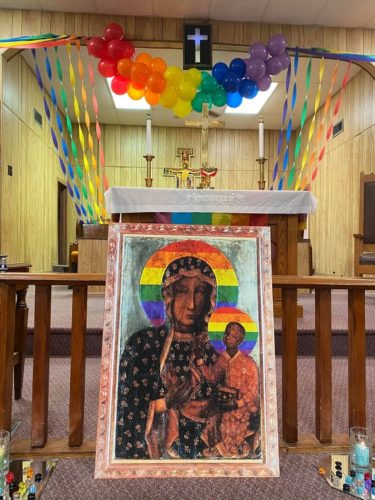
Polish rainbow Madonna at a church that is part of Enid Faith Ways in Enid, Oklahoma in 2021 (Photo by Tammy Neal).
Books about Erzulie Dantor
 Erzulie Dantor and Erzulie Freda are among many Vodou spirits who appear to be LGBT, androgynous or queer. Many others are described in detail in “Queering Creole Spiritual Traditions: Lesbian, Gay, Bisexual, and Transgender Participation in African-Inspired Traditions in the Americas” by Randy P. Conner and David Hatfield Sparks.
Erzulie Dantor and Erzulie Freda are among many Vodou spirits who appear to be LGBT, androgynous or queer. Many others are described in detail in “Queering Creole Spiritual Traditions: Lesbian, Gay, Bisexual, and Transgender Participation in African-Inspired Traditions in the Americas” by Randy P. Conner and David Hatfield Sparks.
These queer Vodou deities include La Sirene, a pansexual mermaid who rules the seas; La Balen, her mysterious butch lesbian intimate companion who is often depicted as a whale; transgender divinity Mawu-Lisa, patron of artists and craftspeople; androgynous Legba, a Christ figure who mediates between the living and the dead; Ayido Wedo and Danbala, a married pair of queer rainbow serpents who bring prosperity, joy and peace; the sexually complex Gede family that oversees the transition to the afterlife; and many more. Each loa or spirit can possess or engage in spiritual marriage with Vodou practitioners of either gender, leading to many queer possibilities.
 Erzulie Dantor and the rest of the Erzili pantheon of Vodoun spirits are explored in an artful yet scholarly way in the 2019 book “Ezili’s Mirrors: Imagining Black Queer Genders” by Omise’eke Natasha Tinsley. She weaves queer black feminist theory with historical research an her own quest to learn from her spiritual ancestors. Tinsley is associate professor of African and African Diaspora Studies at the University of Texas.
Erzulie Dantor and the rest of the Erzili pantheon of Vodoun spirits are explored in an artful yet scholarly way in the 2019 book “Ezili’s Mirrors: Imagining Black Queer Genders” by Omise’eke Natasha Tinsley. She weaves queer black feminist theory with historical research an her own quest to learn from her spiritual ancestors. Tinsley is associate professor of African and African Diaspora Studies at the University of Texas.
A 2019 book exploring Erzulie Dantor and the others is “Queering Black Atlantic Religions: Transcorporeality in Candomblé, Santería, and Vodou” by Roberto Strongman, associate professor of comparative Caribbean cultural studies at the University of California, Santa Barbara.
2019 book exploring Erzulie Dantor and the others is “Queering Black Atlantic Religions: Transcorporeality in Candomblé, Santería, and Vodou” by Roberto Strongman, associate professor of comparative Caribbean cultural studies at the University of California, Santa Barbara.
Black Madonnas inspire artists today
Artist Brandon Buehring sketched a contemporary “Erzulie and Devotee” in his “Legendary Love: A Queer History Project.” He uses pencil sketches and essays “to remind queer people and our allies of our sacred birthright as healers, educators, truth-tellers, spiritual leaders, warriors and artists.” The project features 20 sketches of queer historical and mythological figures from many cultures around the world. He has a M.Ed. degree in counseling with an LGBT emphasis from North Carolina State University in Raleigh. He works in higher education administration as well as being a freelance illustrator based in Northampton, Massachusetts.
Black Madonna figures continue to inspire folk artists and fine artists. One of the best known and most controversial contemporary Black Madonnas is the 1996 painting “The Holy Virgin Mary” by British artist Chris Ofili. He surrounded a stylized black Madonna with mixed media including elephant dung and images from pornography and blaxploitation movies. While using shock value to critique definitions of sacred and profane, he enraged the religious right.
Throughout history some church officials have attacked images such as Erzulie Dantor as illegitimate and incompatible with Christianity. But many Haitian Christians today see Vodou as a way to enhance their faith. Meanwhile Our Lady of Czestochowa is celebrated for revealing the dark face of God’s own mother.
Books related to the Black Madonna
“The Moonlit Path: Reflections on the Dark Feminine” edited by Fred Gustafson (9 of 16 essays are on the Black Madonna with authors such as theologian Matthew Fox)
“Holiness and the Feminine Spirit: The Art of Janet McKenzie,” edited by Susan Perry, includes many black Madonnas in an art book to nourish devotion to Mary with reflections by diverse women.
“Mother of God Similar to Fire” with icons by William Hart McNichols and reflections by Mirabai Starr presents a wide of variety of liberating icons of Mary, including a black Madonna. McNichols is a New Mexico artist and Catholic priest who has been rebuked by church leaders for making icons of LGBT-affirming martyrs and saints not approved by the church.
“Goddess and God in the World: Conversations in Embodied Theology” by Carol P. Christ and Judith Plaskow. Two pioneering leaders in the study of women and religion discuss the nature of God / Goddess.
“Alone of All Her Sex: The Myth and the Cult of the Virgin Mary” by cultural historian Marina Warner shows how the figure of Mary was shaped by goddess legends and other historical circumstances, resulting in an inferior status for women.
“Healing Journeys with the Black Madonna: Chants, Music, and Sacred Practices of the Great Goddess” by Alessandra Belloni with a foreword by Matthew Fox (2019). The book is an experiential guide to the ancient healing rituals of the Black Madonna, including access to 12 audio tracks. One chapter focuses on the Madonna of Montevergine, including her historic role as patron saint of LGBTQ people.
Links related to the Black Madonna
Madonna of Montevergine: Patron of LGBTQ people since medieval times
Rainbow Mary: LGBTQ-affirming rainbow Mary art sparks protests and celebrations
Support Polish LGBTQ activist arrested for rainbow Virgin Mary posters
Queer Lady of Guadalupe: Artists re-imagine an icon
Mary, Diana and Artemis: Feast of Assumption has lesbian goddess roots
___
To read this article in Polish translation, go to contact us:
Czarna Madonna zostaje obrończynią lesbijek: Erzuli Dantor i Matka Boża Częstochowska (Don’t Shoot the Prophet blog)
Modlitwa do Tęczowego Chrystusa (Rainbow Christ Prayer in Polish)
To read this article in Russian, go to:
Ченстоховская Божья матерь — защитница лесбиянок (nuntiare.org)
___
Top image credit
Left: The original Black Madonna of Czestochowa from Wikipedia, also available on Amazon. Right: Erzulie Dantor from the Tanabe Studio Etsy shop, also available on Amazon.
____
This post is part of the LGBTQ Saints series by Kittredge Cherry. Traditional and alternative saints, people in the Bible, LGBTQ martyrs, authors, theologians, religious leaders, artists, deities and other figures of special interest to lesbian, gay, bisexual and transgender and queer (LGBTQ) people and our allies are covered.
Editor’s note: This article was originally published on Q Spirit in August 2017, was expanded with new material over time, and was most recently updated on Sept. 7, 2023.
Copyright © Kittredge Cherry. All rights reserved.
Qspirit.net presents the Jesus in Love Blog on LGBTQ spirituality.


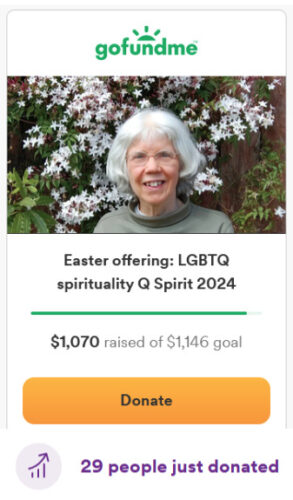






Very nice, I learn some good things about the black madonna. Thank you.
Very glad to have found your site! Thanks for referencing our book Queering Creole Spiritual Traditions in the Black Madonna entry. We’re about finished with an updated, expanded edition of our earlier Encyclopedia of Queer Myth, Symbol amd Spirit, now entitled the LGBTQ Companion to Symbology, Mythology, Folklore, and Spirituality. Have signed up for your newsletter. Thanks for your work, David Hatfield Sparks and Randy P. Conner
Thanks for commenting and subscribing to my Q Spirit Newsletter. Congrats on the new and updated edition of your valuable encyclopedia!